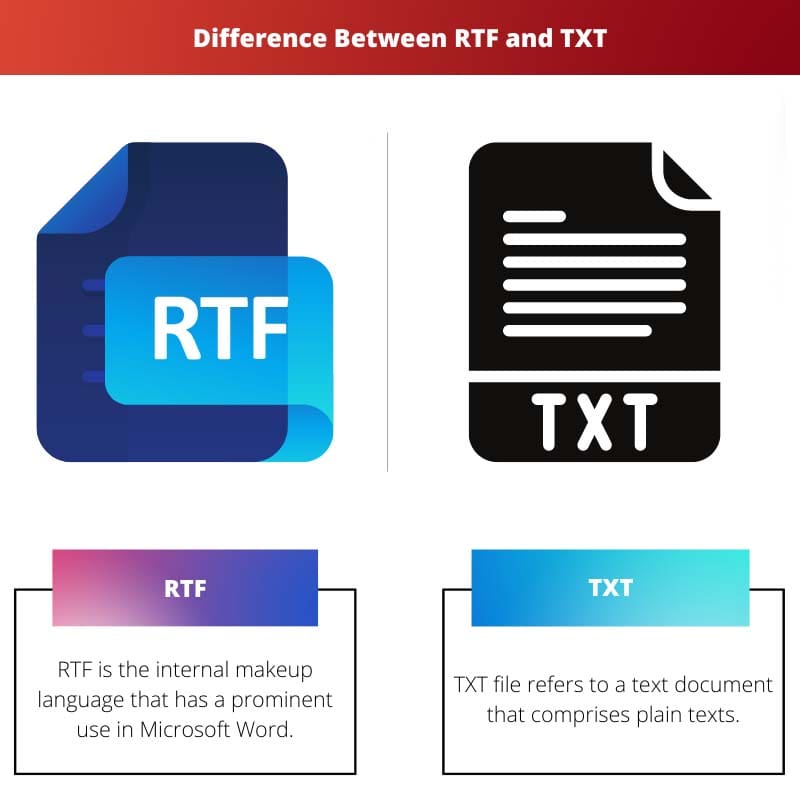File formats provide a standardized and organized forum for encoding necessary information within the computer. Several different types of file formats are in everyday use today.
While some may be open, still others may be unpublished. RTF and TXT are two such file formats that are in wide circulation across processing systems. While they may be confused to mean the same things, RTF and TXT have several differences.
Key Takeaways
- RTF (Rich Text Format) supports text formatting and basic document layout, while TXT (Plain Text) only stores unformatted text.
- RTF files can include various font styles, sizes, and colors, whereas TXT files cannot display such formatting.
- TXT files are smaller and more universally compatible than RTF files, making them suitable for text storage and sharing.
RTF vs TXT
RTF (Rich Text Format) and TXT (Plain Text Format) are two file formats for text documents. RTF allows for formatting such as fonts, sizes, and colors. TXT files contain unformatted text, only supporting basic character set with no special formatting options.

RTF is the internal makeup language that is prominent in Microsoft Word. There are several merits of the Rich Text Format files. The most significant of these is that they do not spread viruses.
Furthermore, they are relatively easy to use and access from different operating systems. Every Word Processing program can read RTF format.
TXT file refers to a text document that comprises plain text. The only formatting that may be allowed on TXT is the provision of line breaks and spacing between paragraphs or words.
However, a TXT is considered disadvantageous due to a lack of data integrity. Additionally, there is no specific way to organize data in the TXT files.
Comparison Table
| Parameters of Comparison | RTF | TXT |
|---|---|---|
| Meaning | RTF refers to Rich Text Format. | TXT refers to plain text. |
| Images | RTF files can include attached photos. | TXT files do not provide the provision of adding photos. |
| Extension name | TF files have a .rtf file extension. | TXT files have a .txt file extension. |
| Advantage | RTF does not spread viruses and is relatively easy to use. | RTF files are significantly larger. |
| Disadvantage | RTF files are significantly larger in size. | TXT files lack data integrity and are inefficient. |
What is RTF?
RTF stands for Rich Text Format. RTF was developed by the Microsoft Corporation in 1987. RTF is the internal makeup language that is prominent in Microsoft Word.
RTF allows for the use of formatting like italics, bold, underline and so on. In addition, Rich Text File enables users to write coloured text and choose different fonts.
RTF allows the inclusion of several different picture formats within itself. Some of these formats are JPEG, Apple PICT, Windows Device Independent Bitmap, and PNG.
However, RTF does not display a picture in software that does not support the format of the image. Every Word Processing program can read RTF format.
The initial objective of introducing RTF was to ensure the existence of a file that could be assessed even by individuals who did not use Microsoft Word.
RTF also functioned as the building block of the Windows help files before HTML files superseded it. An individual can access an RTF by double-clicking the file.
Although Microsoft discontinued Rich Text Format Files in 2008, they are still popularly shared by and supported by apps on almost all operating systems.
Rich Text Format files are in joint circulation because of their relative ease of operation. In addition, it does not lead to the spread of viruses on an individual’s device.
What is TXT?
TXT file refers to a text document that comprises plain text. The basic texts, furthermore, are in the form of lines. A TXT file can be assessed in any word processor or text editor on various operating systems.
The text in the TXT files is easily readable to individuals and consists of a sequence of characters.
A text file is capable of storing a large amount of data. This is because such files have no restrictions on the content size. Nonetheless, the text editors which may be used to access such files should be compatible with loading and displaying them on the screen. There are no specifications for the Text File Format.
The text in the Text Format files lacks any formatting such as bold, italics, or underlined. Furthermore, there is no option to use coloured texts or change fonts.
Thus, TXT serves as a primary text format. The only formatting that may be allowed on TXT is the provision of line breaks and spacing between paragraphs or words.
A fundamental advantage of text files is that they are versatile and of a small size. They can be accessed on operating systems that use even the most essential software.
However, a significant disadvantage of TXT files is their relative simplicity. Redundancy may also be a likely outcome of using the text format files.
Main Differences Between RTF and TXT
- While RTF stands for Rich Text Format, TXT stands for plain text files.
- RTF files allow the basic formatting of texts. On the other hand, there are little to no formatting provisions in the text files.
- A user can add basic images in Rich Text Format files. However, no images can be attached to plain text files.
- An advantage of Rich Text Format files is their relative ease of operation. In contrast, the merit of text files is that they are versatile and of a small size.
- RTF files are larger as compared to plain text files.




